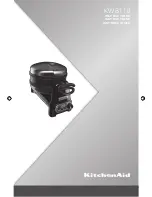
1
3
4
5
6
7
8
2
3
4
3. Parts and Description
1. Cover: With a transparent window to allow interior visibility.
2. Ice Scoop
3. Ice Shovel
4. Ice Basket (stores the ice)
5. Control Panel
6. Handle
7. Ice Sensor: Stops Ice
productions when
Ice Basket is full
8. Water Drain Cap:
Quick release valve
to drain water from
the unit
Maximum Water Level Mark can be found on the water tank, below
the Ice Basket.
Control Panel
A) Selection Button
B) Power Button (to turn unit on and off)
C) “Full Ice” Indicator Light
D) “Add Water” Indicator Light
E) Ice Size Indicator Light
L = Large Size Cubes
M = Medium Size Cubes
S = Small Size Cubes
4. Operating Procedures & Maintenance
A. Unpacking your Ice Maker
1. Remove the exterior and interior packaging. Check that the Ice Basket
and Ice Scoop are included. If any parts are missing, please contact
our customer service centre.
2. Clean the interior with lukewarm water and a soft cloth. Take out the
basket and clean it.
3. Find a location for your Ice Maker that is protected from direct sunlight
and other sources of heat (i.e: stove, furnace, radiator). Place the Ice
Maker on a level surface. Make sure that there is at least 13 cm of
space between the back and sides of your Ice Maker and the wall.
4. Allow at least one hour for the refrigerant fluid to settle before plugging
the Ice Maker in.
5. The appliance must be positioned so that the plug is accessible.
B. Connecting your Ice Maker
* Improper use of the earthed plug can result in the risk of electrical shock.
If the power cord is damaged please call our customer service centre.
1. This unit should be properly earthed for your safety. The power cord
of this appliance is equipped with a three prong plug which mates with
a standard three prong wall outlet to minimize the possibility of electric
shock.
2. Plug your appliance into an exclusive, properly installed, earthed wall
outlet. Do not under any circumstances, cut or remove the third (earth)
prong from the power cord. Any questions concerning power and/or
earthing should be directed toward a certified electrician.
3. This appliance requires a standard 220 ~ 240 volt, 50Hz electrical
outlet with three prong earth.
Before using your Ice Maker, it is strongly recommended to clean it
thoroughly
DANGER
Select
Power
Ice
add
water
S
M
L
E
C
D
B
A
The ice maker is not designed to be installed in an outside area such as a
garage or a porch. Ambient temperatures of below 10°C or above 38°C will hinder
the performance of the appliance.

























